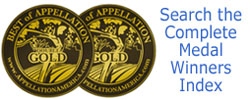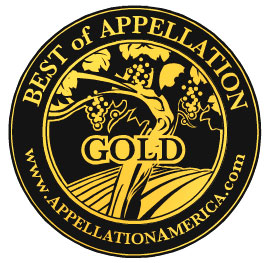Best-of-Appellation Evaluation Program
and the character of each appellation
is defined by its best wines.
True wine lovers embrace diversity in wine, and we at Appellation America have started a program that elucidates one of the most important sources of diversity. This is the diversity that arises from the distinctive characteristics of each appellation — something well understood in Europe but under-recognized on this side of the Atlantic.
Our mission is to explore and celebrate this diversity, building place-identity for the hundreds of wine-growing regions of North America and helping to expand the market for North American wines.
THE PROCESS
The Best-of-Appellation process involves structured tastings designed to identify the specific wine characteristics associated with each region. Wines that are determined by the BOA Panel to best express the characteristics of their appellation earn Appellation America's "Best-of-Appellation" awards (Gold and Double Gold medals).
In the BOA process, the "best" wines are defined by their own place of origin, NOT by the personal taste preferences of our expert panel.
THE PRODUCTS
Our Blue Book of Appellation Taste Profiles is a living document that profiles the characteristics of each appellation.
Tasting Notes are recorded for each evaluated wine and for medal winning wines these appear on our online wine lists (and make great reading, by the way!).
FIRST PRINCIPLES
The place defines the wines; the wines define the place. To a large extent, wine character reflects its place of origin. Local soil and climate, regional cultural traditions and market influences all leave their stamp. The patterns we discover in these "tastes-of-place" generate stories that come to define each appellation in the public mind.
ORGANIZATIONAL STRUCTURE
Step One is to map the region’s vineyards so we understand the soil and climate of each wine we taste, supported by winegrowing professionals from the region who share their depth of experience. Step Two is to review “Product Info Forms” submitted by the wineries to better understand local grape-growing and winemaking. Step Three is to research the role of history and market influences so that a comprehensive and unique profile emerges.
Our BOA evaluations Director, Clark Smith, has responsibility for selecting panelists, making Blue Book entries, and writing BOA-related articles.
MORE ABOUT PROCESS
Tastings are initially blind as to producer, but otherwise panelists are informed to the maximum extent. The panelists act collegially, openly discussing the wines as they review each “flight”. Wines are grouped for tasting according to wine type and appellation, permitting the panel to observe and articulate flavor and style trends that define a region. These are recorded in our Blue Book, which may contain several style profiles within a wine type for a single region.
Next, wines are judged for "typicity" (how well they exemplify a region’s wines).
Finally, the identity of the wines and the producer information is revealed to lend further information to the understanding of appellation characteristics.
It must be emphasized that the Blue Book is not the "final word". Appellation identity is an organic and on-going process. It is vital that wineries continue to submit wines once the profile is established, so that it can be further refined.
[>] More about Evaluation Process & the Evaluators




